Plan your Xinjiang Tour in autumn? Xinjiang is the largest province in China, the size of three “France”. Xinjiang is situated in the most northwest of China, bordering Russia, Mongolia, Kazakhstan, Kyrgyzstan, Tajikistan, Afghanistan, Pakistan and India.
Xinjiang is rich in natural resources with a splendor of varied landscapes featuring high mountains, basins, deserts, glaciers, clear lakes with a diversity of plants and animals. If you are going to explore Xinjiang in autumn ( September and October), we’d like to reveal you the top places to see fall foliage in Xinjiang.
1. Autumn Leaves at Hemu Village 禾木乡秋色
Hemu Village is within Burjin County, in the north of Xinjiang, close to the Mongolian and Russian borders. It is a small village inhabited by hundreds of households with over 1000 people. They are mostly Mongols, Kazakhstan and Tuwa people.
The Tuwa people are legendarily the descendants of a Mongolian tribe. They lives on the south bank of the Kanas Lake. Believing Lamaism, Tuwa people are a brave ethic minority with a long history. Tuwa people speak Turkish, like the language of Kazakh, and live on hunting and graze. They also have their own unique folk custom.
Hemu Village is located on the plain ringed by the mountains on all sides with Hemu River passing through. Outside the villages are rows of diversifoliu poplar trees and birch trees. When autumn comes, layer upon layer of trees” are dabbled with golden colors, a scene of typically primeval forest . Just walking up on the north bank, you look down at the village submerged in the fall foliage, a palette of colors.
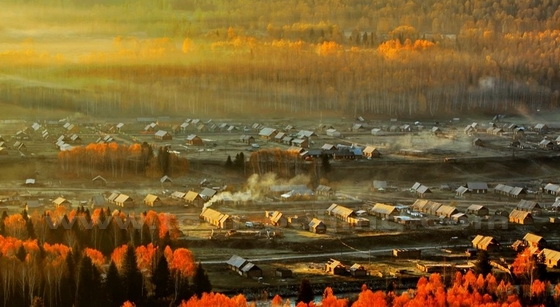
2.Autumn View at Kanas, Xinjiang 喀纳斯秋色
Kanas is located in the northern tip of Xinjiang. The Kanas Lake (Kanasi Hu) means “beautiful, rich and mysterious” in Mongolian. The lake is nestled in the deep forests and mountains of Altay. The lake is 1,374m above sea level and covers an area of 45sqkm (10 times bigger than Tianchi on Bogda Mountain) with the deepest point of 188m.
The long bean-shaped lake reflects the surrounding snowcapped mountains. The Kanas Lake in autumn is at its best with the beautiful foliage. Legend has it that huge monsters live in the lake. They often has take away horses and camels drinking into the water by the lake and later swallow them, a similar story of “Nessie Monster”.
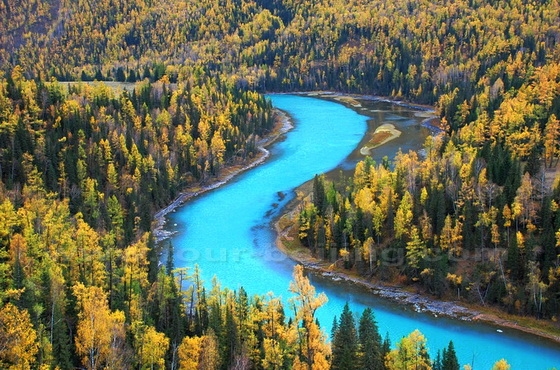
3. Bai Lake 白湖秋色
Bai Lake, literally “White Lake”, is located at the Friendship Peak at Altai Mountains, to the northeast of Kanas Lake. Bai Lake lies at the altitudeof 1954 m with an area of 10 km square .
Bai Lake features the mirror-like water surface surrounded by the mountains on all the sides with stunning views – glaciers shrouded peaks, flowery grasslands, floating clouds, a magic change of colors. This area has a well-preserved forest of Siberian Siberian Taiga. The rare Xinjiang five leave pine trees. When autumn comes, Bai Lake becomes a fairyland of colors.
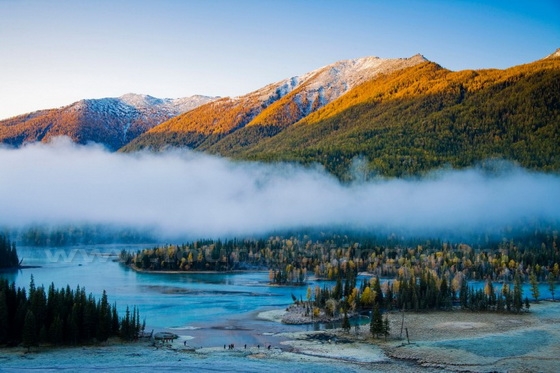
4. Fall Foliage at Baihaba 白哈巴秋景
Baihaba Village is located in the most northwest corner of China, 31 km west of Kanas Lake. It takes two hours to drive from Kanas Lake Scenic Area to Baihaba Village.
Baihaba Village is divided into three living areas – Mongols and Tuwa people area, Kazakhstan area and the special area for the frontier soldiers. This village features the largest population of Tuwa people with well-preserved Tuwa traditional buidlings and rich Tuwa folk customs. When winter comes, the whole area is blanketed by the mesmerizing autumn leaves.
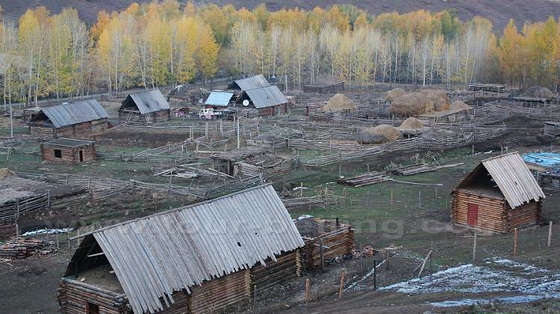
5. Poplar Trees at Luntai County 轮台胡杨林
Luntai County boasts the largest poplar area in China. Luntai Poplar Forest is located in the north of Taklimakan Desert, the middle portion of Tarim River. south on the Luntai County.
It is said that the poplar trees have an unusual vitality that enables it to survive for 3,000 years by living for one thousand years, standing still for another one thousand years after death, and remaining not rotten for one thousand years. Autumn is the best season to view the autumn hue of poplar trees at Luntai.
6. Autumn Scenery at Bayinbuluke Grasslands Xinjiang 巴音布鲁克草原
Bayinbuluke Grassland is located in the middle of Tianshan Mountains, all year round surrounded by snow caped mountains on its four sides, in central Xinjiang Uygur Autonomous Region at the sea level of 2500 meters with an area of 22,000 square km, the second largest grassland, just after Ordos Grassland.
Bayinbuluke literally means “rich with springs” in Mongolian language. Bayinbuluke Grassland is typical of Grass meadow steppe, one of the most important herding and grazing area. The abundant rainfall,coupled by snow melting water, form zigzaging streams and lakes, making it one of the fast grass meadow growing place in Xinjiang. It is actually a huge swamp made up of many small connectedlakes, also a place for Nature Reserve for the swan in China. When autumn comes, the landscape is stunning!
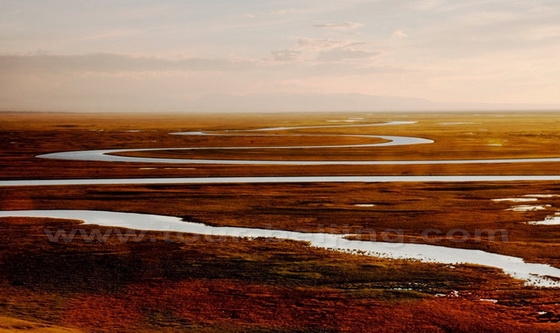
Add-on
Top 10 Places to visit in Xinjiang
Any questions, just a drop a line.






Hello,
What month will be good to see the autumn foliage in Xinjiang- Kanas & Bayinbuluke Grasslands .
Is end Sept too early?
Hi,
I think the best time is from October 01 through 15, half a month.
Hi, the company that organize the tour start on the 12th oct to the 22nd oct, do you think is too late to see the autumn leaves?
Dear Ng poy sin,
Not too late. It is all right to see the autumn hues between the 12th oct to the 22nd oct. But the best is around Mid-October.